

FROM THE DESK OF CHRISTINE EGNOSKI
When the board first approached me 25 years ago about quitting my then full-time job and becoming the Executive Director of the Portrait Society, I was so excited about the possibilities of a change in career from the legal field to the visual arts.
I was looking forward to making a difference for artists all over the country through our programs, publications, and other educational opportunities. One of the things I didn’t expect but has been rewarding is the deep and long-lasting relationships. I have benefited greatly from getting to know the artists that join the Portrait Society as well as the ones that volunteer to serve on our board.
It is with great sadness that I share that Judith Carducci has passed away at the age of 88. We met at the first Portrait Society conference when her work was accepted as a finalist and awarded Best of Show. Over the years, our friendship grew to the next level as she served on the Board and then when we created the Cecilia Beaux Forum, a committee within the Portrait Society, formed to encourage women, help them grow professionally, and make the public aware of women’s art. Judy agreed to serve as the first Chair. She helped to create the mission statement, establish three volunteer committees, and complete a two-year project that culminated with the Inspiring Figures exhibition at the Butler Museum.
Judy, like many women artists, had an art career interrupted in her twenties. Initially trained by private instruction since the age of 6, she changed tracks in college, and after graduation, she went to work for the Cleveland Veterans Administration. After 30 years as a social worker, she retired and returned to art which allowed her to achieve success, recognition and 25-year career painting portraits, still lifes and plein air.
It was my pleasure to work with her on the Cecilia Beaux Forum committee, and we had many lively discussions about portraiture, women in the arts, and life in general. I admired and loved Judy on so many levels. Judy once said of her service to the Portrait Society, “To be part of a program to give people mentoring and tools to work toward their goals in our profession, and to be part of the team of artists who volunteer their time to these ends, has been a great privilege.” I believe that Judy’s legacy will continue through the works she created, the friendships she built, and the positive changes she contributed to within the Portrait Society.
Board Members
Michael Shane Neal, Chair, Nashville, Tennessee
Dawn Whitelaw, Vice-Chair, Franklin, Tennessee
Wende Caporale-Greene, Treasurer/Secretary, Woodbury, Connecticut
Quang Ho, Denver, Colorado
Mary Whyte, Charleston, South Carolina
Executive Director
Christine Egnoski


Advisory Board
Sam Adoquei, New York, New York
James Gurney, Rhinebeck, New York
Robert Liberace, Vienna, Virginia
Dean Mitchell, Tampa, Florida
Rhoda Sherbell, N.A., Westbury, New York
Burton Silverman, N. A., New York, New York
Jennifer Welty, Santa Cruz, California
Staff & Newsletter Contributors
Kim Azzarito, Assistant Director
Amanda Oliver, Membership Director
Allison Gilliard, Special Programs and Outreach
Kerry Vosler, Writer, State Ambassador Coordinator
Wende Caporale-Greene, Writer, Board Member
Scott Jones, Writer, Washington State Ambassador
Mailing address:
Portrait Society of America P.O. Box 11272 Tallahassee, FL 32302
Shipping address: 1109 S. Magnolia Ave. Tallahassee, FL 32301
Toll free Telephone: 1-877-772-4321
Fax: 850-222-7890
Christine Egnoski Executive DirectorTABLE OF CONTENTS
3 New Works: Tim Rees, Louise Weir, Amy Werntz, and Ned Bittinger
4 In Memoriam: Judith Carducci
6 Future Generation Competition Winners
9 State Ambassador Report: Kerry Vosler

10 Feature: Kim Azzarito
15 Business Side of Art: Scott Jones
16 A Day in the Life: Wende Caporale-Greene
18 Step by Step: Brooke Olivarez
20 Portrait Society Member News
22 New and Renewing Members: June, July, August
24 Call for Entries
Shane Wolf, Sentry I (detail), 78x35”, charcoal, sanguine, chalk & pierre noire on SW paper
Web: www.portraitsociety.org
The Art of the Portrait® Newsletter is published quarterly by the Portrait Society of America. All contents copyright Portrait Society (unless otherwise noted). No part or whole of this newsletter may be reproduced or transmitted in any form unless prior express consent has been given. Please send submissions to the editor at the Portrait Society.
Design
Charity Myers I THE CREATIVE POOL DESIGN charity@thecreativepooldesign.com

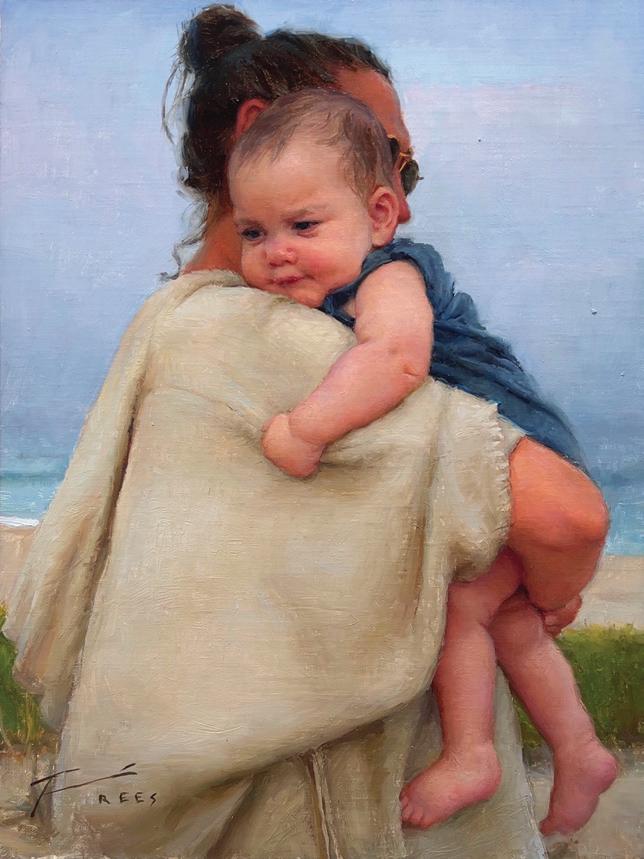


A MODEL OF PERSEVERANCE
 By Christine Egnoski
By Christine Egnoski
About six years ago at my very first Portrait Society convention, I was facing a significant birthday and went there to cheer on my friend, David Kassan, for the Draper award. At that time, I saw and heard Judith Carducci speak about her journey. It felt like an absolute perfect moment. I desperately wanted to quit my job and become a full-time artist. After her speech, I approached her and told her my thoughts…she was so generous to take her time to speak to me. She then looked at me and said, “If not now, when?” Those words resonated, and I returned home and quit my job. The last six years have been more than I could’ve ever anticipated! Two of the major highlights are being in the top 20 finalists in the Portrait Society’s International Portrait Competition and getting selected for Signature Status.”
I received this email from Portrait Society member Barbara Hack after hearing the news of Judy’s recent passing. Judy believed in helping and encouraging others to follow their own artistic journey.
Being an artist was always an essential part of Judy’s identity. She started her formal training at the age of five and fondly recalls having always been introduced by her relatives and teachers as “the artist.” In a recent interview, she recalled, “When I was eleven and in the 6th grade, the local school board decreed that I would no longer be released from school for my private art lessons. I had been studying privately for 6 years at that point. My parents met with the board, pointing out that I was not behind in any of my schoolwork and that art was to be my life’s work. At the time the public school did not offer any comparable training. But the board held its ground. On the day of my first art class after that, my father appeared in my schoolroom, told the teacher he was taking me to my art class, and told me to get my coat. My parents argued the case all the way to the Massachusetts State Board of Education, and they won! This was a pivotal experience for me: it taught me that it was possible to fight City Hall and win (being appropriately assertive and with a good cause). It gave me confidence in my worth as an artist because my parents believed it important enough to go to such lengths. It has affected my whole life.”
Upon entering college, Judy’s plans to become an artist were waylaid, and she graduated with her masters and became a social worker. Always with a love of art and a desire to go back full-time, she raised her son, David, and after 31 years in social work, she retired and embarked on what would be a 25-year career as an artist and teacher. She was a Founding, Signature, Board, and faculty member of the Portrait Society, and she served as the first Chair of the Cecilia Beaux Forum, a committee within the Portrait Society dedicated to strengthening the careers of women artists. She was the perfect person to serve in this capacity as she experienced and conquered the career interruptions and late starts so often faced by woman.
In addition to being a full-time artist, she has taught workshops around the United States as well as internationally. An only child of two teachers, Judy said, “I LOVE teaching! It’s probably genetic. Both my parents were teachers, and I married a teacher. There’s nothing more fun or energizing except painting, and teaching incorporates painting. It’s important to give back, to contribute to the profession. I didn’t begin to teach until I was sure I could

help a student grow without my stepping on his own style and creativity; I don’t want my students to become derivative, but to be themselves. I emphasize two things: first, learn to draw and paint from life before using photos as references, and second, ask aesthetic questions, such as ‘why am I painting this, and what is it in this project that excites and interests me?’ A work of fine art is more than a display of technique.”
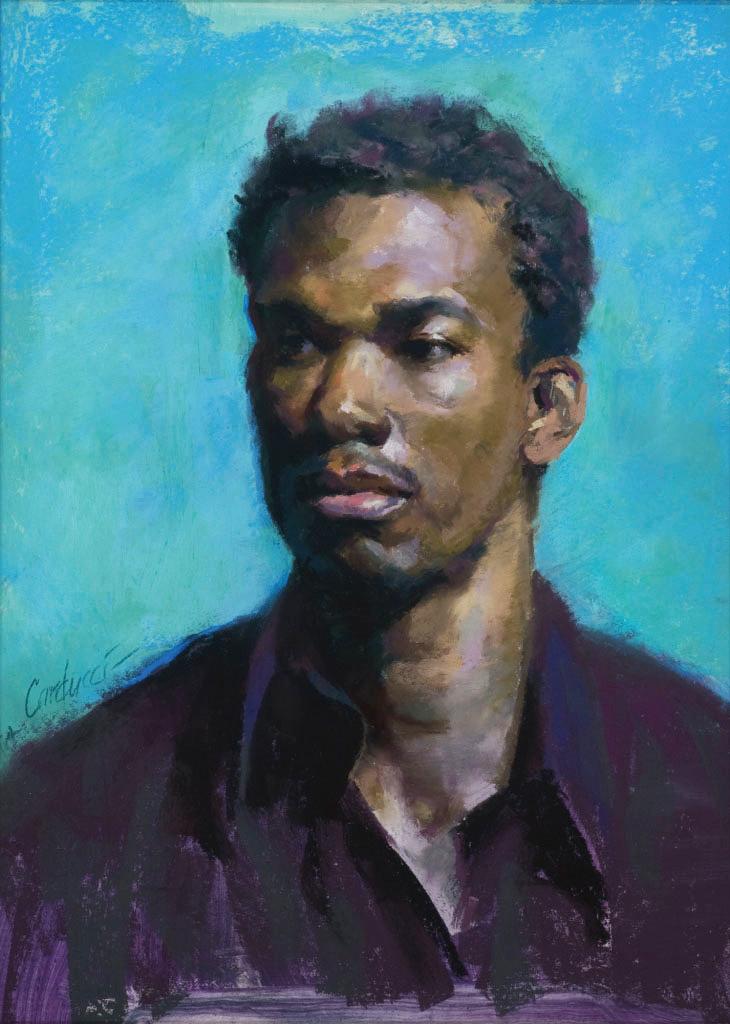

Judy recently attended the Portrait Society’s conference and posed for artists Rose Frantzen and Jeff Hein. In addition to watching a fantastic demonstration, attendees were treated to a non-stop conversation between all three artists. During the demo Judy commented, “What a thrill this is for me because 25 years ago, here in Reston, when they had the first conference, my painting won the Best of Show, and who could have imagined then, that my career would have taken off like that after 30 years of not painting, and we would be here 25 years later posing for Jeff and Rose– it’s an amazing feeling.” At the end of the demo, Judy was given a standing ovation. She stayed afterwards to sign her newly published autobiography titled Rose Reversal, My Life In-Out-In Art.
Judy’s contributions to the art world and her dedication to helping her fellow artists will surely be remembered and celebrated for years to come.

JUDITH CARDUCCI SCHOLARSHIP
In honor and memory of Judy’s many contributions to the visual arts, the Portrait Society and her son, David, have established a scholarship to be awarded to a deserving student to attend the annual conference which will include tuition, travel stipend, and hotel accommodations. To contribute to this scholarship fund, please visit the Portrait Society website at www.portraitsociety.org.
LOOKING TO THE FUTURE: A New Generation of Portrait Artists
Recently, we had the pleasure of announcing the winners of the fourth annual The Future Generation Competition. This competition was created to acknowledge the work of talented, emerging artists, who are 18 to 25 years old. Early recognition in art competitions can have an incredible and lasting impact on a young artist’s career, as it once did for John Singer Sargent, who at the age of twenty-three, won Honorable Mention at the Paris Salon for a portrait of his teacher, Carolus-Duran. Since the competition’s creation four years ago, we have seen a remarkable caliber of work submitted by the best and brightest the field has to offer. This year, the selected panel of judges were Dawn Whitelaw, Louis Carr, and Stephanie Paige Thomson. Together they reviewed over 200 entries from young artists around the world, including Canada, China, Germany, India, Israel, Italy, Kazakhstan, Mexico, New Zealand, Romania, Singapore, Spain, Sweden, the United Kingdom, and the US. Four top place awards were selected along with 12 Finalists and 12 Honorable Mentions. In their own words, the four top place winners, Elizabeth Ralph-Smith, Stefano Curti, Ava Liberace, and Phoebe-Louise Stewart Carter, share their background, what drew them to art, and the inspiration behind their winning works.
By Kimberly AzzaritoThe inspiration for Miriam in White came from reading To the Lighthouse by Virginia Woolf. In this novel, the focus shifts between various characters, with their inner complexities driving the narrative rather than any singular event or action. I was particularly struck by Woolf’s depiction of women, each portrayed with their own unique flaws, strengths, and perceptions of the world. With Miriam in White, I wanted to capture the same kind of depth— placing emphasis not on any specific action taking place but on the person within the painting, engaging the viewer with a challenging gaze. I wanted people to look at the piece with a critical eye and see a critical eye looking back at them. I work directly from nature, so throughout this project I was able to learn more about Miriam. Our conversations informed my decision-making throughout the painting process, and as I learned about her interests, dislikes, studies, and aspirations, I was aided in my endeavor to capture her character beyond the visual surface. In this piece, I hoped to capture a kind of psychological heaviness that I believe is felt by many people—including myself—who are trying to navigate the challenges and unsteadiness of life.
I was first introduced to the arts through the New Zealand Suzuki Institute, where I learned to play piano from the age of four. I performed piano in various locations throughout New Zealand, along with plays and musicals in Auckland Theaters. In 2018, I graduated from Sancta Maria College as Valedictorian with scholarships awarded for my English studies and Photography. In 2019, I was accepted into the Florence Academy of Art and travelled to Italy to pursue formal education in the traditional methods of drawing and painting. Upon graduating with a Diploma in Painting in 2022, I was awarded a graduate in residence position and was given the opportunity to work independently in a studio provided by the school as a 4th year of specialization.
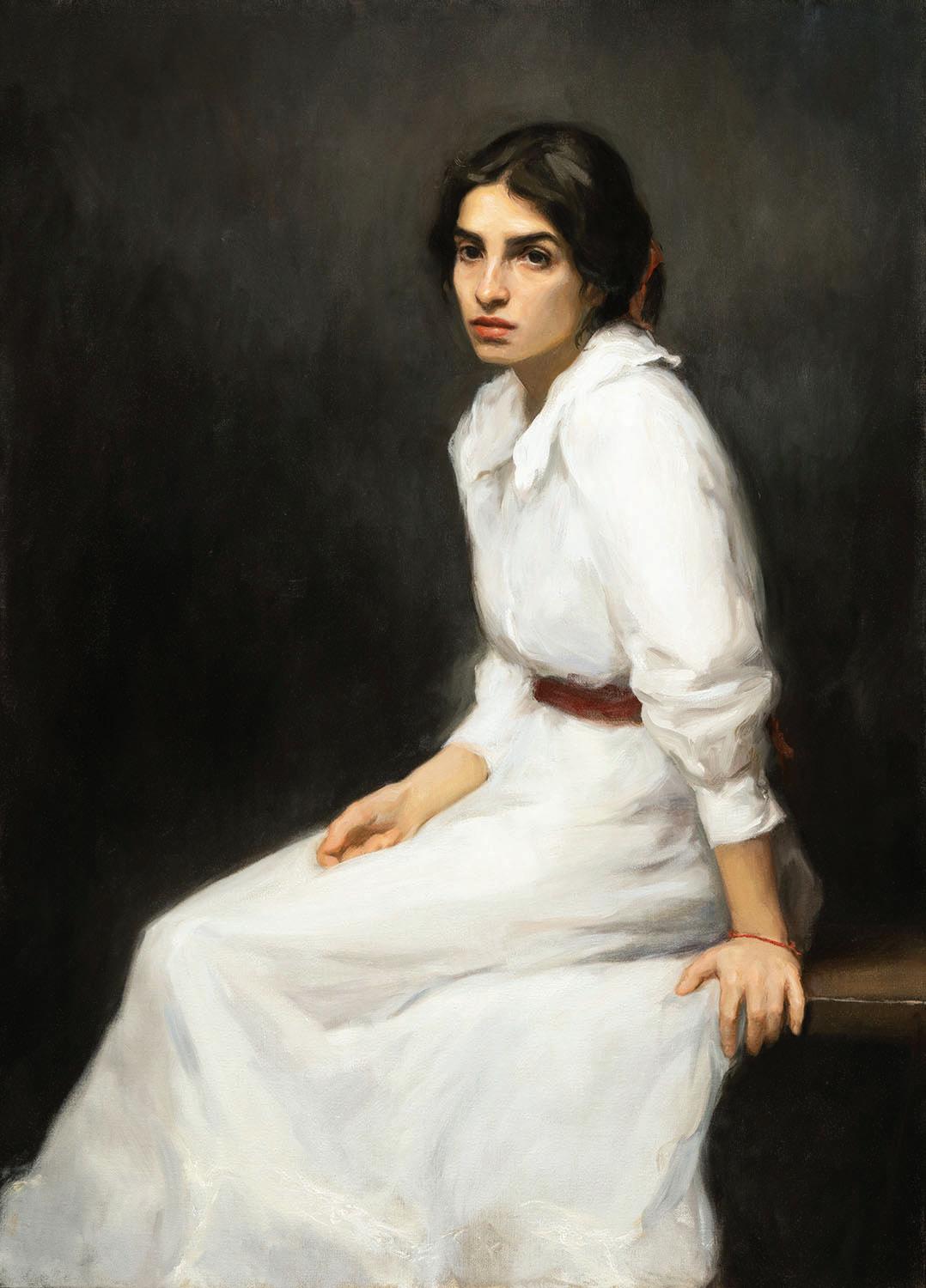
Though I have always been drawn to creative arts (English Literature, Art, and Music), I found that I liked the visual storytelling that painting offered. I was drawn more and more toward figurative art by the connections between literature and painting, for example John William Waterhouse’s painting Ophelia (1894) depicting a character from Shakespeare’s play, Hamlet. Painting always felt to me like an opportunity to tell the story of a moment in time— to preserve the world the way I see it with both its beauty and complexities, the same way that authors have done with the written word for centuries.
I was introduced to Lukas by mutual friends who had heard me go on about my love for suits and my desire to get one custom-made. They had mentioned that one of their friends was a tailor who worked at a prestigious bespoke shop, and I immediately inquired about him sitting for a portrait, hoping we could trade a painting for suit. As soon as we met, it was obvious we’d be good friends, and so we drafted up an idea for the suit, and I had him come to stand for a painting. I work from life exclusively, and I did this painting in what I believe was a quick six sittings. He stood in the cold of our garage for a while, and then down in my studio. We had fun, we grew to be even greater friends, and the portrait is proof of an exchange that happens between two people who make and have a passion for making. It’s a reverence for craft. Lukas wanted some sort of interior that would speak about that reverence, and I wanted a cluttered background to have him contrast against. I also thought about Moroni’s portrait of a tailor and felt I could draw upon that sensation without the explicit demonstration of his craft. Lukas is bathed in a light cast downward, and he gazes with a quiet friendliness which speaks for his intriguing and intelligent character.

I had art classes throughout my K-12 education, and at the end of 8th grade, I became more invested in art and joined the National Junior Art Honors Society. My teacher, Mr. Sacco, was an incredible influence on me. He was the one who bought me my first dip pen and ink (which I subsequently spilled over the floor out of sheer clumsiness). I decided to go to the School of Visual Arts (SVA) for several reasons, but one of the major ones was because of its Chair of Illustration and Cartooning, Mr. Thomas Woodruff, who has now retired. Mr. Woodruff mentored me and gave me such incredible tools, as did TM Davy, who is a wonderful portrait artist, along with Peter Fiore, Dave King, Bruce Waldman, Sam Weber, Dennis Kardon, Marvin Mattelson, and many more amazing mentors during my time at SVA. I was taught an immense number of technical
skills, but still, painting--like anything--is a product of the ambition of its practitioner, their continuous work in furthering their practice, and their love of learning.
For a long time, art was about the wild landscapes of my imagination, and back then I only wanted to be a graphic novelist. I still haven’t abandoned that, as I write and illustrate them eagerly to this day. However, the major event that brought me to portraiture was during my first year of college at SVA. My painting foundation teacher had brought us to the Frick, and for the first time I saw the Comtesse d’Haussonville by Ingres. After that moment I felt this great longing to make something of that caliber or beyond. It still seems strange to me how that did so much to forge my path. It was a moment of complete resonance with the painting. I always had an urge to draw people and had been doing so for a while before my trip to the Frick, so I think it reified that passion rather than forming it.
The drawing began as an exercise on anatomy and an admiration for how the body can evolve and stretch. Every time I begin at this stage, I am reconnected with the idea of the body as a vessel, vastly capable and admirable. I carry these ideas to inform the experimentation with poses and photography, and the drawing evolved naturally into an almost monstrous figure of amalgamated limbs. It was an extremely consuming and liberating process; I obsessed over the anatomy of ribcage muscles, then got tired of details, so I drew another foot. With time, I developed an entangled, contorted mesh of continuous limbs and their ghosts, memories of the body, the vessel.

I grew up in Northern Virginia where I attended a public high school and practiced drawing and painting at home. Currently, I am a junior working towards a bachelor’s degree in both biology and studio art at Wesleyan University, Connecticut. I mostly took after my parents and sister in learning a more academic style of drawing, and after I went to college, I used this exposure as a foundation to experiment with abstraction. My family are all, individually, great sources of inspiration. They all have incredibly distinct styles when it comes to illustration and/or painting, and that definitely encouraged me to explore my own language. Along with that formative exposure, we’ve all taken many trips to museums across the United States and in Europe, which not only directed me towards the style of past artists I felt most drawn to, but exposed me to different architectural spaces or social scenes that served to inform new compositional ideas. The more I expose myself to these areas of life, I feel the need to record, so all my drawings hold strong memories of how I perceived my surroundings at that moment. It’s become quite an emotional practice of record keeping.
This portrait was painted very soon after I graduated from my studies. I wanted to challenge myself by painting a subject with very light skin. I experimented with under glazing rich transparent reds and greens to try and bring color and warmth to Giulia’s white skin and jet-black hair. I was inspired by John Singer Sargent’s painting of Madam X, which uses layers of complimentary colors to achieve such rich colors within a fairly muted subject. This portrait was painted completely from life. After studying art in high school, I joined Sarum Studios in Salisbury, England, studying under artist Nicholas Beer in the sight size technique. In 2018 I travelled to Florence for a more rigorous tuition of the same practice at the Florence Academy of Art. After completing the three-year course, I was awarded an artist in residence prize. I was able to teach both the firstyear students and the advanced third-year painting groups during my residency - which I feel was just as, if not more, educational for me as it was for the students.

The need for draftsmanship was the first topic that drew me into painting. I have always gravitated towards portraiture. People are endlessly interesting, and undergoing the task of painting or drawing them is a challenging one. I noticed a lack of emphasis on technique, skill, and draftsmanship in most painting and drawing instruction I had as a teenager and sought after an education that would teach me this. Only after falling in love with painting as a craft, I became interested in being exploratory and creative with these skills.
Finalists: Sofia Arevalo, Olivia Arts, Varad Bang, Caden Ferita, Tina Figarelli, Astrid Gaszynski, Shangying Jia, Mattie Ree Neal, Tatiana Popova, Camila Salinas, Daniel Zalla, and Yang Zhang
Honorable Mentions: Joanna Bigelow, Leo Bignell, Cameron Copley-Heissig, Kayley Jane Dykman, Nick Ensing, Stanley Hope, Kristine Iljina, Gabriel Lewis, Andre Melchor, Livia Lynne Miller, Shiori Mori, and Kalina Tosheva
This season has come in with a flurry of activity from our ambassadors. Despite the economy, artists are continuing to thrive.
Our thoughts are with our ambassador in Hawaii, Janis Casco Blayer. The catastrophic Lahaina fire wiped out 80% of the community and several art galleries. She and her husband survived, but it will take time to rebuild the once thriving arts community.

Here are a few highlights from our ambassadors.
Dianna Porter (Indiana) planned and executed her regional exhibit and live paint event. Sixteen artists from Indiana, Kentucky, Illinois, and Ohio participated in an exhibit hosted by Hancock County Arts, with help from Alice Heddon and Bernade Flournoy. Forty-three works of art were displayed, along with a live demonstration by artists of local radio celebrity models entitled, “A Face for Radio” (pictured). It was so successful they are planning another exhibit next year. We love it when our ambassadors partner up from neighboring states.
Shari Lyon (Utah) continues to plan monthly gatherings/ potlucks quarterly for members.
Katherine Cook (Florida) and her new Co-Ambassador, Deborah Broach Ferro, are revamping a new Florida members only Facebook page.
Rachel Christensen (California) moved from Utah and is now co-ambassador with Nancy van Buskirk (CA).
Alison Landry (Virginia and Washington, DC) will host a meet and greet at the National Portrait Gallery for sketching and conversation on November 5, 2023.
Janelle Hatherly (Australia & New Zealand) reported that the ‘DownUnders,’ continue to gather and are expecting their 8th Newsletter in October, compiled and written by Janelle featuring DownUnder member artists.
Cat Nunn (Vermont and New Hampshire) has compiled a brand-new newsletter by Cat featuring New England members and their events and activities.
Billy Seccombe (New Jersey) started out with a July event featuring Betsy Ashton’s “Portrait of Immigrants.” Members enjoyed her inspirational story and learning about her mission.
Donna Catotti and Nancy Angelini Crawford (Alaska) had a very successful Museum exhibition of Portrait Society Alaska and Hawaii members back in May. Simultaneously, Kerry Dunn did a Studio Incamminati workshop, and Yuko Hays did a threehour portrait demo with Donna as part of the show.
Jeanine Jackson (Connecticut) planned a member’s event with Grace DeVito who shared her major work in progress at the Stamford Studio.
Kathie Wheeler (Wisconsin) is our new ambassador in Wisconsin. She sent a survey to members to refocus the program and is planning a live demonstration for members to be announced.
Rachel Mindrup and Littleton Alston (Nebraska) are gearing up to host Studio Incamminati this upcoming March, and it will be a mix of their Creighton students and Nebraska Portrait Society of America members.
 Kerry Vosler National Ambassador Coordinator
Kerry Vosler National Ambassador Coordinator
Thirty years ago, Chair Michael Shane Neal began in earnest to capture as much as possible the teachings of his mentor and world renowned painter Everett Raymond Kinstler. In his newly released book, The Art of Seeing, he has organized these ‘truths’ in ten chapters including Drawing, Value, Color, Edges and Feeling. It is Neal’s hope that by sharing Kinstler’s teachings he will keep alive the information that others had shared so freely with Kinstler and what he learned and taught during his lifetime.
Mr. Kinstler was a founding board member of the Portrait Society and was devoted to the Portrait Society’s mission, and in gratitude for that devotion, the profits from this book are being donated by Shane to the Portrait Society in Kinstler’s honor. Order today: michaelshaneneal.com/store.

THE BOLD & THE BEAUTIFUL: A CONVERSATION WITH SHANE WOLF
By Kim Azzarito
This past May, during our annual The Art of the Portrait conference, I had the great pleasure of beholding one of Shane Wolf’s monumental figure drawings in person. He was one of twenty selected finalists for The International 2023 competition and received a First Place Drawing award for his work, Distanciation – a stunning 54 by 39-inch drawing in charcoal, sanguine, and chalk. The portrait depicts a rotund male nude standing unapologetically in a purple-hued background with his chin jutted forward and hand on hip. Wolf’s figures are both bold and brave in their depictions of beauty – in all its forms. Recently, I had the chance to talk with Wolf about his process, influences, and future endeavors.
You received a bachelor’s degree in graphic design from the University of Cincinnati and then changed the trajectory of your career to pursue art, what led you to that decision?
Being a designer ultimately wasn’t very fulfilling for me, and it also meant sitting in front of a computer most of the day, which sucked. After four years with a French ski company in Annecy, I decided to backpack around the globe for 16 months and get back to the purity and fun of drawing – for myself. My travels ultimately led me to Florence, Italy, where I studied at the Angel Academy from 2005 to 2009. My four years there were phenomenal, and I left that remarkable city to begin painting professionally in Paris, France, concentrating exclusively on what I was most passionate about: the nude figure, always from life.
You shared that your biggest artistic influence is the models you work with. Can you tell us how you find harmony with your models to create such powerful and dynamic figure drawings?

Finding harmony with my models is at times immediate, and at times an ongoing, building crescendo. The models I choose to work with are those with whom I can have great artistic conversation, almost every single time we work together. Conversely, models I have worked with in the past with whom there was not some kind of artistic chemistry are simply not models I ask back to studio. It is a complete normality that not everyone will connect. Each artist’s inspiration and connection to any given model will, thankfully, be totally personal and subjective.
Do you exclusively work from life? How has this helped or hindered you in your work?
Yes! When working from life, you become part of an ancient artistic and human-centric culture that I feel helps an artist tap into the current of timelessness and universality, of strength and beauty, of vulnerability and truth. It links mankind, and it can be absolutely humbling and absolutely electric! After 15 years of working full-time uniquely from life, I have observed that those who do so tend to have a unique vision and interpretation of humanity in their art. I believe this to be largely thanks to the undeniable exchange of energies between the artist and the model, the artist and the work, and the work and the model: it is a very palpable triad.
I have never accepted the typical excuse that it is too costly to work from models. My perspective was always that I cannot afford to NOT work from life. This is how we improve our skills, how we learn about people, our community, our world, and our place in it. The idea of crunching away in the studio with computer screens and photos instead of models is utterly appalling.
In some of your art, it appears as if the models are floating, not quite grounded. How do you achieve this placement of bodies?

I have always loved good perspective and strong foreshortening. As soon as I left Florence and set up my own studio in Paris, I practically said good-bye to the model stand and started posing models on high tables, on mezzanines, on ladders, and even used mirrors in all kinds of ways to help me see the model at different angles. All of this allowed me to conceive of some kind of glass platform on which models could pose, thereby allowing me to get any perspective I could ever want. That thing finally became a reality several years ago when I was able to have a steel company in Paris custom build my platform. It was a real game changer and will always be an important tool in my studio.
Earlier this year, you were awarded First Place Drawing in the International Portrait Competition with your piece, Distanciation. You noted that without exception all individuals possess some quality, some characteristic, some essence that is worth studying and capturing artistically. Can you speak a little more on this idea?
Yes, that was an immense honor for which I am very grateful. Outside the figure drawing world, there seems to be the rather predictable stereotype that a nude model should be “attractive” or “fit” or whatever popular culture attempts to define those traits. Even within the figure drawing world, it is not uncommon to encounter this idea. I have been struck by such a wide variety of Beauty that it seems impossible to imagine a model session where I could not find something about him/her worth my artistic energy. Granted, it would be illusory for me to say that a deluge of inspiration hits me every single time, but when I think of sessions where I had to “dig deeper” to find inspiration, there has ALWAYS been something, even if just a detail of the figure. The drawing Distanciation was a great example of someone who would likely not be widely regarded as “beautiful,” but for me he was, and profoundly so.
In 2022, you had an incredible exhibition at the MEAM which brought together nearly 200 pieces of your work including your new monumental drawings and paintings. What inspired you to create the large paintings of Carmina Burana, and can you share a little more about your process?
In one sense I painted my monumental Carmina Burana cycle (roughly 10 x 110 feet) to address an issue we figurative painters face in the art community: that almost all of our work, when purchased, disappears into private collections only to be seen by very few. I am not criticizing this reality, simply observing it. Thus, the general public still seems bewilderingly unaware that we exist. Part of my motivation to go so insanely huge with this project was to—hopefully—short-circuit the galleries and aim straight for museums and foundations where the public could see this work together with its preparatory and process work. It was a big gamble on many levels, and fortunately with the MEAM and the wonderful success of the show it all paid off, having one of the highest ticket sales in the museum’s history!
Another large motivation for this project was as a “call to arms” to my fellow painters around the globe. As we artists are ultimately creating 21st century art history, too few of us are taking serious chances to be Epic, to take a risk with our skills and see where we go. I think some of this is due to the commercial circumstances of the markets, but some of it is also simply due to lack of courage and audacity on the artists’ part. Perhaps that sounds a bit harsh, but sometimes we need a kick in the derrière! It seems that painters of the
past could indeed spend years and years (even a lifetime) on very ambitious projects, and this is a key cultural element we need to keep alive in the 21st century, particularly when technology is pushing so many people in the opposite direction of speediness and superficiality. Depth and meaning come with time and investment, and we all need this. To speak briefly about the process, from the initial compositional sketches and model research, all the way to the last brush strokes, I worked on that project for about 6 years, clocking around 4,000 hours of model time.
Do you have any words of wisdom or advice for a young person just embarking on a career in the arts?
Yes. Being a professional artist is an amazing career, but you have to be disciplined and clock in a lot of long hours doing mundane tasks; the glorified moments of inspiration only represent a minority of your time. You have good years and less good years; the financial roller coaster is part of the creative process you learn to accept and thrive within (hopefully). If you are sensitive to criticism, then don’t listen to anyone. If you’re not, then don’t listen to anyone. Be sincere in

what you pursue. A great sense of humor is quite the asset, as is a genuine smile. Take the long, hard, and often solitary road if that’s what it takes. And ENJOY THE RIDE!
Lastly, can you share any current or future projects you are working on? Aspirations for your career?
Carmina Burana was the first time I challenged myself as a painter of monumental and multi-figure formats. Around the same time, I was initially taken by Carmina, another major inspiration hit me, one that I knew I was not “mature” enough to attempt at that time. Now that I am a bit older and have experienced some of life’s most profound events (new life, death, betrayal, deepening love), this new project is calling my name. And I will answer it head on, for as long as it takes.


BUSINESS SIDE OF ART: ARE YOU READY FOR A DOOR TO OPEN?

I have seventeen-plus years of experience of watching people in a gallery setting. I am looking for cues of their interests on specific pieces or artists. I also watch for clues that they might be artists. The cock of the head, up close, back and forth, and squinting – artists do squint more.
I will often ask, “Are you a doer, art appreciator, or both?” I like people self-defining themselves as an appreciator of art. If you are an artist, I want to know that. If there is group, I will often ask, “So who’s the artist in the group?” Often all fingers point to the same person. Sometimes everyone points at a different person, and I comment that we are all artists.
Assume you are that artist standing in my gallery, and I have now identified you as an artist. Are you ready to walk through the door I just opened? The vast majority of artists will deflect, tell me that they are not that good, or it’s just a hobby, which is fine. But what if you are selling your artwork or aspire to do so? Wayne Gretsky said, “You miss one hundred percent of the shots you don’t take!” How do you take your shot? Let’s get down to some BASICS:
• Be ready to concisely explain what you do, what inspires you, and what you hope to do with your art in the future. Have a couple examples of your best, recent work QUICKLY accessible on your cell phone to show if invited.
• Have an Instagram and/or Facebook account updated with recent work and your art likes. I have no problem with an artist asking me if I am on Instagram. I may also invite artists to follow me. I do follow back, and I always look through their posts.
• Have your website updated with your best and most recent work. Too many websites haven’t been updated in months or years. I like prices on websites. Availability of good, high-res photos is a must.
• Provide opportunity to sign up for a newsletter and send one out at least monthly. I find it surprising the low percentage of newsletters I receive given that I signed up. Email lists are the lifeblood of our business. Repeat sales are essential. Work your email list!
• Always have a business card to leave. I never take a card without looking up the artist. I gave a presentation at the Portrait Society where I invited everyone to stand up and stretch and bring me a business card. Less than a quarter of the room had one. I made the point that I was going to look every card up online and added, “What will I find?”
I spend too much time on Instagram and Facebook looking at artists. Sometimes a door can open with just one post. For example, I have a Facebook notification today of being friends with Marina Dieul for 13 years. I was planning a drawing event in Scottsdale in 2010. I scoured my list of artists, business
By Scott Jones
cards, websites, and Facebook looking for guest artists to invite. I remember running across Marina Dieul on Facebook for the first time and her new conte drawing La Bergeronnette I scrolled through her other posts and website. I emailed her that I would like the drawing in the show. She had a highresolution image immediately available to meet a very short catalog deadline. Just two years later, we hosted a two-artist show with Marina and Hsin-Yao Tseng where both painters exhibited and sold their Finalists paintings from that year’s International Portrait Competition. This was personally memorable for me because that was my first year attending the Portrait Society conference. Add a couple more years, and I remember counting that we had sold well over 100 of Marina’s paintings (and still counting). She could never have expected an opportunity with a Western Art Gallery, but she was ready for it. You don’t know when or where that door will open. I’ve seen the Portrait Society open many doors.
Scott Jones has been a passionate art collector since the age of 16, and after a successful exit from the business world, shifted his focus to his passion, selling art. He is currently a Sales Consultant for Cole Gallery in Edmonds, Washington and serves as State Ambassador of Washington for the Portrait Society.

A DAY IN THE LIFE
Sharon Sprung has achieved a level of accomplishment that is coveted by most artists’ standards. Pursuing her fascination with realism at the commencement of her career, she has been associated with Henoch Gallery in the Tony Chelsea area of Manhattan for decades where her one-person exhibitions are a major event. Painting figurative subjects for many years eventually led to recognition by the National Portrait Gallery’s Outwin Boochever Portrait Competition and subsequent commissioned portraits. The pinnacle has been the recent unveiling of her portrait of First Lady Michelle Obama for the White House collection. Sharon is also a renowned teacher of figurative painting at the Art Students League.

 By Wende Caporale-Greene
By Wende Caporale-Greene
I asked Sharon to tell me a little about an average day.
Surprisingly, Sharon Sprung begins our conversation with the pronouncement that her life is simple, perhaps even mundane. She gets up at between 7:30 and 8:30 AM, grabs a jug of water, avoiding breakfast, and immediately goes to the studio to begin working. She works all day with little desire to do anything else. Her studio is where she wants to be, where she feels safest in the world, and where she expresses herself. She acknowledges that she has few hobbies and refers to herself as a “gregarious hermit”; if someone gets her out of the studio, she enjoys herself, but she seldom takes the time of her own initiative. She does admit that she can get people-shy from spending so much time alone. She faithfully works six days a week, ending her day somewhere from 5:00p to 9:00p, except on the two mornings when she teaches. Even though she tries to stand all day, which helps keep her focused and enables her to walk back and forth, Sharon does not get tired. She greatly enjoys spending her time in the studio fully engaged with her work and related activities. Modestly, Sharon reinforces that her life is “ordinary.” She enjoys her garden and having lunch there with her two dogs, her only companions who only interrupt once in a while. She is busy painting and thoroughly enjoying it.
Having a reputation as a renowned teacher of painting at the Art Students League in New York, I wondered if Sharon is currently teaching now.
For the first time in 20 years, Sharon decided not to teach at the ASL this summer. She realized she would miss the opportunity for new students but will return this September. In the meantime, she is happy to have taken the time to devote to finishing paintings.
With the monumental distinction of having painted the official White House portrait of First Lady Michelle Obama, I wanted to know how her life has changed. What kind of assistance does she have?

Sharon works with someone who does social media and posts on Facebook and Instagram along with sending out letters and updates to her mailing list. Sharon is very pleased with her creativity and performance. This leads Sharon to be creative in her thinking about what she wants to share and has led to quotes that she likes, sharing early student work and a broader spectrum of material involving painters and comparing paintings. However, sharing information on a public forum can be revealing and can leave us vulnerable.
Aside from her social media assistant, Sharon does not have help with administrative tasks. She prefers to handle these herself, spending time in the evenings for one hour or less in an attempt to keep up with writing letters and making appointments. Being a visual person, she finds that writing does not come easily; it takes effort to write notes and communicate in a civil fashion.
Most importantly, Sharon is grateful for the help and support of her husband, Bill, who cooks and arranges take-out as needed from their Brooklyn neighborhood. “Bill does everything, and it’s always been that way.” His work takes him away from their home three to four days a week. With Sharon’s studio on the third floor of their shared home, this arrangement suits her. He has always been supportive and made space for Sharon’s work. He concluded after first meeting Sharon that she was “very focused.” Later, he modified his prediction saying that Sharon was “obsessed.” When their only son was a teenager, one day as he walked up the stairs to Sharon’s studio, Bill admonished him saying he shouldn’t disturb his mother because “she was making money now.” Sharon laughs at the thought but is always glad when Bill warns people not to risk bothering her while she’s working. She spends Sundays with Bill, taking care of family duties and seeing friends. Her needs are simple, with the exception of fashion, her one indulgence.
I wanted to know if she ever questions the validity of what she is doing.
Sharon refers to her pursuit of painting as a survival mechanism. It is the only thing that she can contribute that feels important. She rarely questions herself because what she does feels right to her: painting people and by doing so, attempting to honor them. She greatly enjoys working with her sitters for whom she has great respect having been recognized by their worthiness for an official portrait. Sharon is a warm, compassionate person, and her clients connect with her. Every portrait provides something to learn so she is continually challenged by the process and what each encounter presents. She summons her ability to move the bar technically or compositionally selecting the appropriate context for each sitter. She explains that what she does is to “reinforce humanity - it’s very respectful. We dive into people’s psyche.” She’s doing what she is capable of in the best way she can, that she feels is her contribution.
Having discovered a book by the late artist, Charles Pfahl, I ask Sharon if she was influenced by him.
She explains that they were very close friends and perhaps in the way that friends tend to influence each other. He was older, more established, very helpful and generous by introducing Sharon to influential people. She admired and respected his work and though technically there might have been some crossover, their work was very different. Pfahl was a darker person whereas Sharon is drawn to optimism, a characteristic reflected in her work. She remarked that what she did learn from Pfahl was how to be more audacious.
Sharon is a highly regarded teacher of painting and enjoys the interaction with her students. She once asked them what one painting had a profound influence on them. Further, did it prompt them to decide that this was the direction they would choose to follow? Her own epiphany came when she first saw Andrew Wyeth’s painting Christina’s World. To Sharon, the painting epitomized the 1950’s and 60’s; Christina’s World metaphorically “signified struggle, working uphill, analogous
to salmon swimming upstream facing obstacles.” Although Sharon had yet to begin painting, she recognized this image represented her personal experience and what she had done in her own life.
She always gravitated towards realistic artists. Although she shared that my late husband, Daniel Greene, with whom she studied early on, provided great organization and solid information, Wyeth’s painting influenced her on a preconscious level before she even knew she wanted to be a painter. The latter made her keenly aware of how she was drawn to the visual.
Finally, I wanted to know what Sharon aspires to accomplish in the future?
Sharon remarks how she is very pleased to have accomplished things she had not envisioned. Right now, she prefers to focus on portraits. Not currently interested in doing her own paintings, she does have some ideas and will get back to her own work in the future. Right now, she is absorbed with the prospect of painting people of substance and import, people in the public. Because of her genuine affinity for humanity, people trust her. She does not turn work away but instead enjoys the fact that “everything is a challenge.” Having reached the pinnacle of the portrait profession, there is no doubt Sharon can handle whatever challenge comes her way.
Wende Caporale-Greene is an award-winning artist and nationally known teacher of portraiture. She is a Master Pastelist with the Pastel Society of America and serves on the boards of the Artists’ Fellowship, Hudson Valley Art Association, and the Portrait Society of America
White
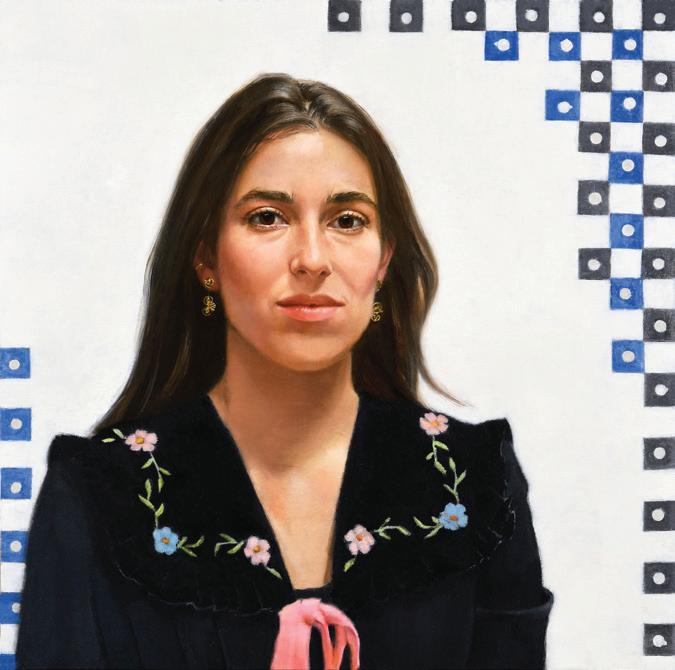
STEP BY STEP: BROOKE OLIVARES
Step 1:
I often begin a watercolor with a loose pencil gesture of the big shapes. I find that relying heavily on the gesture and overall mood allows me to apply the paint more freely than if I am confined to a tight drawing. I make sure the scale of the figures fits comfortably within the environment/composition and take stock of where my light source is coming from, so as to not overwork those light areas early on in the process. I then begin applying washes of neutral warms and cool colors with a large brush, not worrying if the paint runs together. This helps to create a unified color palette overall and leads to a less fragmented final. This watercolor was done using Strathmore, Bristol Smooth, 4ply. This surface is extremely versatile and allows for easy lifting of the watercolor when things need to shift or be re-drawn later in the process.

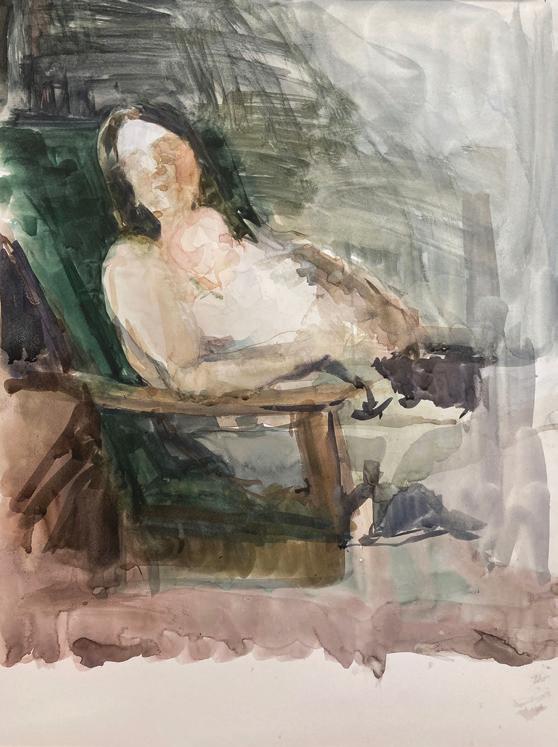

Step 2:
After the initial block-in of shapes, I begin narrowing in on what part of the subject I want to have in focus and what part of the subject can be simplified or edited. In this instance, the cool blue light cascading over my mother and son was my central focus. I began carving out more heavily the light masses of the figures using the dark values of the green rocking chair as the framework. This is where drawing meets sculpting, and my aim was to make my mom really feel relaxed and weighty in the chair. I focused on angles of her posture and gesture and pushed the drawing until the feeling came through.
Step 3:
Once I felt comfortable with the overall placement, I began tightening up the drawing of the head starting with light washes and working into the darks. As you can see, the eyes are mostly simple shapes with no tiny details. This is the stage where you begin to find what is essential in your photo reference and what information can be left out. If not chained to your reference, your artistic point of view can be more freely expressed.
Step 4:
Once my mother’s portrait was mostly complete, it gave me a concrete anchor point to base the other drawing decisions around. I painted my son’s head with very light washes as well and then gradually added in the darks in a few key places such as the nostrils, mouth and ears. In this stage, I also heavily consider the use of hard and soft edges as well as what passages of the painting I want to keep unrefined by allowing the initial gesture to come through. I find it liberating to let one stroke make the statement without overworking the whole with excessive detail.
Step 5:
I find it important to note that throughout all these stages, I constantly use a mirror to check my work for drawing accuracy, readability, and composition. In the case of this piece, the legs and floor were never part of my initial sketch or vision. The more I worked on it, however, the composition didn’t feel right when I would check it in the mirror. Thankfully, I had left a border of white at the bottom which allowed for the extension of the piece. The forgiveness of the paper was also a saving grace, as I was able to apply washes of water to create a seamless transition into the new part of the painting. In this final stage, I added several darker washes to the back wall and floor to unify my values of the environment and figures and to prevent those two areas from competing for attention. I wanted the lightest lights to be in the figures and for the environment to play a supporting role. Final touches included some opaque strokes of gouache on the baby’s outfit and on the slippers to reinforce the light and form.
Final Note:
When deciding on what to paint or how to paint it, don’t be afraid to let your vision shift throughout the process. Step away from your piece often; it will keep your mind fresh and allow you to revisit it with a renewed perspective.
Brooke Olivares is a representational painter based out of Sarasota, Florida, originally from San Diego, CA. She earned her BFA in Illustration from Ringling College of Art and Design in 2006 and continued further study at the Illustration Academy. Her work has received numerous awards including First Place in Painting from the Portrait Society of America’s International Competition in 2016 and was a Finalist in 2017. She is currently represented by Kiley Court Gallery, in Provincetown, MA.
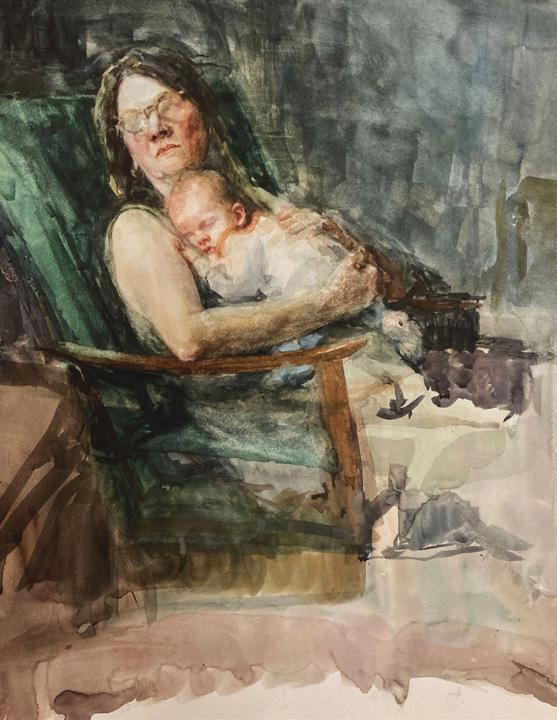
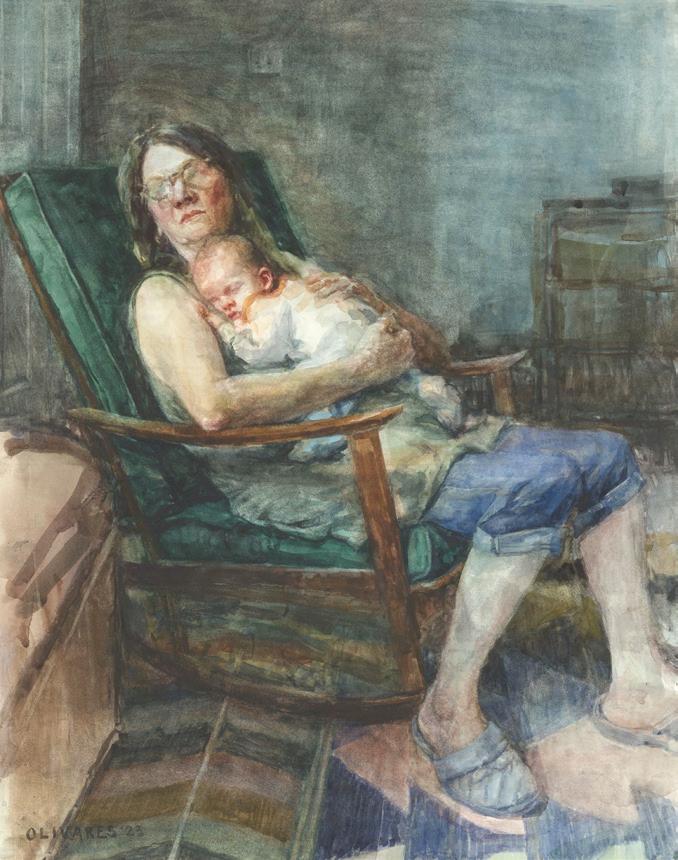
Sound Asleep, 14.75x19”, watercolor and gouache

1. Tony Armendariz won the Mary Bryan Memorial Award and Medal for watercolor at the Allied Artists of America 110th Juried Exhibition for his painting, Mr. Stripes
2. Melanie H. Bates’ official portrait of KY Governor Andy Beshear was unveiled in the rotunda of the State Capital. Preceding this, the Governor hosted close friends in his home for a private unveiling.

3. Nora Dempsey’s painting, Aspirations, was selected as part of the FAV15% (jury’s favorite 15% of the entries) in the May 2023 BoldBrush Painting competition.
4. Nanette Fluhr’s painting, Portrait of My Grandfather, was selected as part of the FAV15% (jury’s favorite 15% of the entries) in the May 2023 BoldBrush Painting competition.
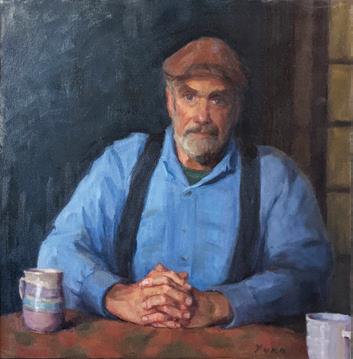


5. Barbara Hack’s portrait Katherine in Red was accepted to the 38th Annual Bosque Art Classic.

6. Yuko Hays’ portrait Ed won the People’s Choice Award with the most votes in the Portrait Society of America’s “The Outliers” exhibition at the Haynes Sheldon Museum for Alaska and Hawaii members.

7. Lisa Kovvuri’s painting Passing Hours was awarded Best of Show in the National Oil and Acrylic Painters Society Best of America 2023 Exhibition.
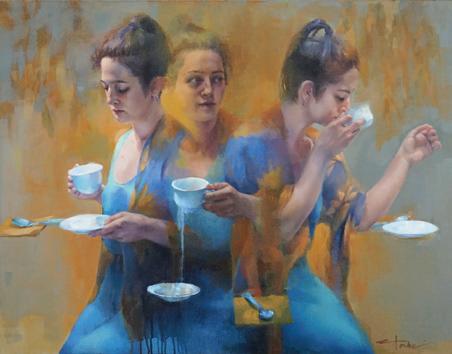

Mary Lazar’s painting Primary Colors to Love was juried into the Library Arts Center Juried NH/VT Regional Exhibit, which was on display until the end of September 2023.
8. Sookyi Lee was selected as an honorable mention in The Best of Watercolor Splash 24 Art competition, sponsored by Artists Network. Pictured: Sookyi Lee, Blue No.1, watercolor on paper

9. Cathy Locke was awarded “First Place in Painting” for her work Tea Leaves which was selected from among 1,700 submissions to the Triton Museum’s 2D Art Competition and Exhibition, Salon at the Triton 2023.
10. Laurie Maddalina’s drawing Grizabella was chosen as one of 10 Honorable Mention winners in the prestigious Strokes of Genius 15: The Best of Drawing art competition, Artist Magazine.

Carol Peebles received 2nd Place at the Haggin Museum International exhibition for Pastels USA:99Voices, with this piece No Where To Be But Here, a demo from life for blueeaselclub.com Atelier.
Billy Seccombe announced the unveiling of his portrait commission of the 1930’s Dean of Union College Hubert Huntley. The work will join their permanent collection and be prominently displayed in their college boardroom.
Kaysha Siemens’ recent piece Artemis of the Spears has been chosen as a finalist in the Beautiful Bizarre Art Prize.
exhibitions
1. Mika Denny’s portrait drawing of Lindsay was accepted into the 59th Annual Anaheim Art Association’s Juried Exhibition. The exhibit runs from September 23 through November 5, 2023 in the Main Gallery at the beautiful Muzeo Museum and Cultural Center in Anaheim, California.

2. Forty-one Portrait Society artists were juried into the International Guild of Realism’s Fall Salon Online Exhibition, on display October 20-December 20, 2023. The entire juried show will be featured on two important art websites: www.realismguild.com and www. americanartcollector.com. Pictured: Jesse Lane, Witness, 30x20”, colored pencil
3. Several Portrait Society artists, including Kerry Dunn, Natalie Italiano, and Lea Colie Wight, are featured in “What We Face: Portraits and Stories of the Ukrainian Refugee Experience” exhibit at Studio Incamminati, on display through November 30, 2023. Visit studioincamminati.edu for more information about this unique exhibit. Pictured: Kerry Dunn, Julie, 22x28”, oil on canvas
workshops
4. Quang Ho and Adrienne Stein, along with CW Mundy and Vanessa Rothe, are teaching the “Americans in Paris” workshop next April 23-May 23, 2024. Visit workshopsinfrance. com to learn more and register. Pictured: Adrienne Stein, The Gift, 48x30”, oil
5. Charles Miano is teaching an Oil Painting workshop next January 22-26, 2024, at Miano Academy of Art. He will share the painting method he uses to create stunning and lifelike portraits in oil. Learn more and register online at mianoacademy.org.




6. Mardie Rees is teaching a Portrait Sculpture Workshop next January 18-20, 2024, at Vosler Atelier in Tampa, Florida. Students will sculpt two portraits at half life-size in water clay on a fixed armature, while working from a live model. Visit www. mardierees.com for more information and to register.
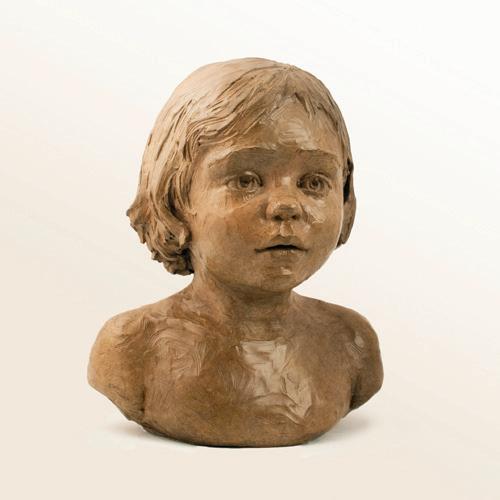
7. Scottsdale Artists’ School is featuring several workshops this fall with Portrait Society artists. Visit scottsdaleartschool.org for more information and to register.

November 6-10, 2023: Figure Painting with Accuracy and Confidence with Anna Rose Bain.
November 13-16, 2023: Expressive Portrait Drawing with Oliver Sin.
November 28-December 1, 2023: Painting from Life with Max Ginsburg.
Janice N. Frederick, PA
Julie Gallagher, NJ
Eufrocinio Gamboa, CA
George L. Hageman, OH
Fran Hall, OH
Daryl Hartman, CT
Anthony Hedrick, SC
Olga Hegner, UT
Stephanie Helmey, TN
Holly Henson, GA
Lucinda Herlihy, FL
David P. Hettinger, IL
Bennie Higgins, WI
April Hopkins, TX
Mary Hull, TX
Lori Ippolito, NJ
Anna Jarrell, NC
Dinah Jasensky, AZ
Diana Kirkpatrick, SC
Linda Kollacks, IL
Dave Kupczyk, CA
Nichole Laizure, AZ
Susan LaMantia, OH
Rhonda Lanclos, TX
Glenn Lavezzi, KS
Nancy J. Lewis, GA
Susan Lindsey, AK
Cathy Locke, CA
Elena Marty, CA
Pushpa Mehta, CO
Elizabeth Miller, VA
Candace X. Moore, CA
Paula Moore, FL
Gini Morelock-Bosco, TX
Kay Maureen Moses, NM
Christine Norris, NY
Terri Otten, NC
Kathi Parker, NM
Barbara Pence, TX
Cees C. Penning, FL
Robyn Phillips-Pendleton, DE
Jane Polkowski, FL
Alan Pullman, MA
Diane Reeves, GA
Barbara Rettig, AL
Sara Jane Reynolds, SC
Jen Riddell, GA
Amy Dudash Robinson, NJ
AnaGloria Rodriguez, CO
Allan Rosen, TX
Leah Salerno, TN
David M. Salerno, TN
Karen Schlanderer, MI
Deborah Schlossman, MA
Pamela Schrader, CO
Nan Sherry, TN
Donna Slade, NC
Joan Iatesta Smith, AZ
Tanner Steed, CO
Michael Swann, AL
Sarah Tate, GA
Donna Townsend, OH
Ernest E. Varner, GA
Ann Kraft Walker, TX
Heather Wanamaker, SC
Ronald Wendt, FL
Maria Whitehead, VA
Leah Wiedemer, FL
Patricia W. Wilkes, AR
Marie Williams, TX
Jenny Windsor, VA
International
Gabhan Berry, Scotland
Theo Felizzola, Brazil
Fei Gao, China
Lihuai He, China
Linda LeGrice, Canada
James Middleton, Canada
David Sandell, United Kingdom
Parnita Senjit, United Kingdom
Margaret Taylor, Canada
Tess Turner, Cyprus
NEW MEMBERS
A WARM WELCOME to our new members that joined in June, July, August
JUNE
Patron
Donna Carr, TN
Shawn Farley, CA
Aaron Hill, NC
Michelle Recke, MN
David Wells Roth, MA
Rob Rowe, NC
Ainur Ryskulova, NJ
David Sierra, KY
Jacquelyn Smith, OR
General
Nathan Bartlett, MD
Courtney Bocchicchio, NJ
Jamie Cassaboon, NY
Deb Ehrhardt, VA
Leeahd Goldberg, TX
Tricia Hooker, NC
Sarah Kersey, FL
Hannah Leach, SC
Kara Lin, VA
Debra A. Mandel, NJ
Sue Ann Moore, TX
Emily A. Pastor, OR
Robert Thur, NC
Joy Wade, MO
JULY
Patron
Rita Bartel, CA
Sirisha Bommireddipalli, IL
Michael Butler, GA
Peggy Hagler, AL
Kathy Hough, MI
Julie Johnson, MI
Wendy Kwasny, CA
Arlene Lawrence, CT
Vicky Miller, TX
Caroline Reynolds, NC
Sarah Shaw, IN
Lionel Sosa, TX
Kate Swanson, NY
Wyatt Young, NC
General
Joseph Accorso, NY
Christy Archibald, GA
Audrey Bell, NM
Jaylene Bengtson, NH
Claude Bryant, ME
Diane Lynne Chanako, FL
Debra Cootware, MA
Oliver Crane, UT
Jenny Decker, MS
Stephanie Denham, GA
Lee DuBon, TX
Alan Duckworth, TN
Linda Enerson, MA
Michael Facey, NY
Deborah Hansen, AK
Theresa Kniaz, MA
Slava Kokaev, FL
Christine LaWare, GA
Jim Leach, MI
Patricia Martin, NC
Richard McKnight, PA
Christopher Murray, AL
Tracy Pollock, NJ
John Procyk, NJ
Kathy Render, AL
Megan Rieker, UT
Joan Ruprecht, MN
Sienna Sanchez, FL
Eve Selonke, CA
Alice Shapiro, NC
Cynthia Siegel, CA
Miriel Smith, MI
Yan Tan, CA
Dana Trulock, AL
Eliner Tryon-Elgin, MD
Jessica Mia Vito, MI
Jerry Weems, CA
Dani Wheeler, AZ
Xiaotang Wu, NY
International
Russell Bignold, United
Kingdom
Thomas Coull, New Zealand
Rikki Fisher, Australia
Chantal Graveline, Canada
Saskia Huitema, Netherlands
Dunja Jung, Serbia
Heather Lenefsky, Australia
Swathi Madike, Australia
Jeff Morris, Canada
Meredith Nargang, Canada
Denitsa Stachowski,
Switzerland
Leah Terpsma, Canada
MingYang Zhang, China
Student
Summer L. Foster, FL
Stephanie Meisterling, NE
AUGUST
Patron
Carole Allison, RI
Danielle Connolly, SC
Jeremiah Griswold, OH
Hector Hernandez, FL
Claudia Kaak, Germany
Suzanne Lawson, Australia
Jeff Matkovich, CO
Jose Gonzalez Mendez, AL
Jamie Miceli, FL
Lisa Reifsneider, FL
Bruce Skillicorn, VA
Judy Steffens, IL
Sargent Circle
Joelle Phillips, TN
General
Dona Alexia, CO
Robert Becker, OH
Lori Farist, NY
Fred Fields, KY
Kathleen Fish, MI
Zhongcheng Gao, TX
David Garrison, IA
Rick Hines, IN
Lee Jordan, GA
Tina Katnich, CA
Peter Koenig, FL
Lisa Manzo, CO
Sylvie McClelland, CA
DeAnn Meely, AL
Christopher North, CO
Karl Nygard, WA
Haibin Peng, CA
Chris Elizabeth Richards, NC
Fernando Rodriguez, NY
Kay Salem, TX
Constance Sanocki, MI
Betty Smith, TX
Dorothy Stevens, TN
Peter Van Riper, MD
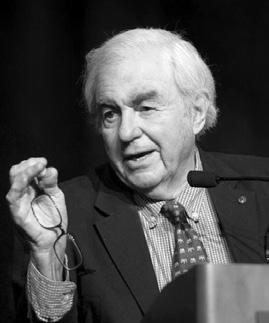

Kathleen Weber, RI
Katie Williams, GA
Yuchen Zhan, IL
Gladys Zhang, NY
International
Chung Wei Chien, Taiwan
Alan Clarke, Ireland
Ruth Fitton, United Kingdom
Elizabeth Hartland, Australia
Natalie Hirschman, South
Africa
Bin Huang, China
Caroline Kelly, New Zealand
Seong Yeon Ko, South Korea
Jie Liu, China
Rhona Pedro, Bermuda
Shunning Wang, China
Rachelli Zohar, Israel
Student
Telisa Owens, UT
MENTORSHIP AND GRANT OPPORTUNITIES
Application Deadline: November 15, 2023
We are pleased to announce the fourth year of the Everett Raymond Kinstler Mentorship Program and the Edward Jonas Grant Opportunity. These two programs assist portrait artists with achieving their goals. The mentorship program provides a year of mentorship, and the grant opportunity provides funding for a project or educational opportunity.
To read the details visit www.portraitsociety.org/services.
The Portrait Society of America
P.O. Box 11272
Tallahassee, FL 32302
CALL FOR ENTRIES
Entering art competitions is an excellent way to grow as an artist and can benefit you in a number of valuable ways – world-wide exposure, exhibitions, and the opportunity to measure your skills in the subject matter against other artists. The Portrait Society offers two upcoming competitions with cash, prizes and worldwide exposure. Submit online at www.portraitsociety.org.
MEMBERS ONLY
Entry deadline: November 2, 2023
FIRST PLACE NON-COMMISSIONED PORTRAIT
Carla Paine, Girl Seated in a Rocking Chair, 24x34”, oil on linen

INTERNATIONAL PORTRAIT COMPETITION
Entry deadline: February 5, 2024
FIRST PLACE PAINTING
Alex Venezia, Autumnal Hymn, 37.5x29”, oil

info@portraitsociety.org
www.portraitsociety.org
877-772-4321
